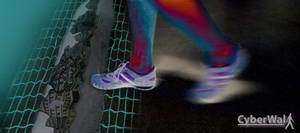CyberWalk - Unconstrained Walking in Virtual Worlds

The development of a walking platform which will allow unconstrained movement in virtual worlds is the goal of the CyberWalk project, initiated by scientists of the Max Planck Institute for Biological Cybernetics in Tuebingen, Germany, together with their colleagues from the Technical University Munich, the Swiss Federal Institute of Technology, Zurich, Switzerland and the University Roma, Italy. The platform will serve as a tool to study human spatial cognition and movement in space, but later will also allow visits to historical sites or help improve training for athletes in virtual environments. The CyberWalk project is supported by the European Union with 1.7 million Euro for the duration of three years.
Source: Walking without restriction in virtual worlds is still a challenge for science and technology. (CyberWalk)
For the creation of so-called "virtual worlds", towns, scenes and situations are reconstructed as lifelike as possible in the form of three dimensional programmes. These virtual scenes are presented to the viewer via a projection screen or specialized glasses equipped with small projectors. In contrast to passively viewing a film, the viewers can move within and interact with the virtual environment. As soon as the viewer turns to the right, for example, they will see the same virtual scene but from another visual angle - the same as in our natural environment. The goal of such developments is to create virtual worlds which are able to give us the feeling that we really are a part them.
To achieve this goal, detailed knowledge of how humans perceive and behave in their natural environment is required. Human perception and cognition are very precise operations, responding, for instance, very sensitively if together with a rotation of the body the environmental image does not "move" at the same angular velocity. If the coordination of the two is less than perfect, the behavior of the person in the virtual environment changes - resulting in vertigo or indisposition.
But what are the benefits of virtual worlds - apart from in the entertainment industry? Even today, virtual worlds are entering many domains: in the industry for creating and visualizing new car models, in architecture, rehabilitation, as well as in the sciences, e.g. for research on human cognition.
To study natural human behavior, the best place to do so is in our natural environment. Usually basic conditions in natural environments change so quickly however that it is nearly impossible to replicate an experiment under exactly the same standardized conditions. Even a cloud moving in front of the sun can completely change the lighting of a scene.
Virtual worlds however allow for controlled and independent changes of all experimental parameters in precisely defined steps. Thus, virtual worlds are the appropriate environment for studying complex human behavior patterns under quasi-natural conditions.
People have always moved through their environments by walking or running. Only movement allows us to explore our surroundings and, for example, orientate ourselves in buildings and cities. But to this day, this natural freedom of movement cannot yet be replicated in virtual worlds. The goal of the CyberWalk Project is to develop of a completely new virtual walking environment, which enables subjects to actively and unrestrictedly move through virtual worlds in different directions. As a first application the team of researchers is planning to create a walk through the ancient Persian city of Sagalassos.
The core of the CyberWalk walking environment will be the so called CyberCarpet. At this stage of the project it is envisioned as a platform, approximately five meter diameter. This platform will consist of thousands of small, loosely pivoted spheres - similar to oversized ball-bearings. The spheres are propelled by a treadmill mounted on a turntable. In this way it will be possible to transport a person walking on the CyberCarpet back to the centre of the platform without them noticing.
The CyberCarpet will be developed in close collaboration between the Department Cognitive and Computational Psychophysics (Prof. Heinrich Bülthoff) of the Max Planck Institute for Biological Cybernetics in Tuebingen, and the Institute for Applied Mechanics (Prof. Heinz Ulbrich) of the Technical University of Munich. The Munich scientists will develop the prototype and construct the final version of the platform. To ensure that walking on the platform will indeed feel completely natural, they will receive guidelines from the Max Planck Institute’s scientists, so that the platform can be tailored to human behavior and perception patterns. A central factor in this will be the effects of forces arising from the platform’s acceleration on human perception and action.
Further partners in the project are scientists of the Institute for Technology and Electrical Engineering (Prof. Luc van Gool) of the Eidgenössische Hochschule Zurich. Their task will be to create a control signal for the platform from visual records of the walking subject - without such a system, subjects would simply fall over the edge of the platform after about three steps. In this task the Zurich scientists will receive support from the Informatics Department of the University of Rome (Prof. Alessandro De Luca), where appropriate software for movement control will be developed, and from the Institute of Automatic Control Engineering and Autonomous Systems (Prof. Martin Buss) at the Technical University of Munich with its expertise in the area of optimized control engineering of robotic systems. Management partner in the project is the Agency for Research Funding AFWO GmbH Tuebingen (Dr. Friederike Wolf-Oberhollenzer).
Dr. Marc Ernst, project scientific leader at the Max-Planck Institute for Biological Cybernetics is convinced: "Once we have made it possible to walk naturally in virtual worlds, the CyberWalk walking environment will be of interest not only to the entertainment industry. It will also have many potential applications in medical therapy, the training of athletes, in museums and in architecture."
The European Commission is supporting the Cyberwalk project for the duration of three years with 1.74 million Euro, the Max-Planck Institute for Biological Cybernetics will receive funding of about 450,000 Euro.
Source: Max-Planck-Gesellschaft


















